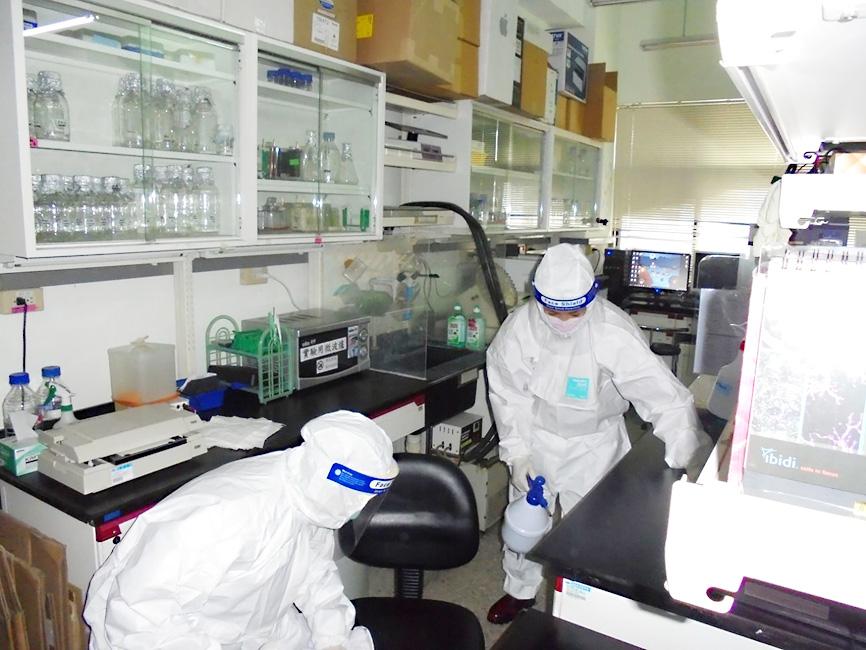The Central Epidemic Command Center (CECC) yesterday said it was easing regulations for home quarantine, as the number of COVID-19 cases rises, but with a large majority reporting no or mild symptoms.
As local community spread might continue to expand, Minister of Health and Welfare Chen Shih-chung (陳時中), who heads the center, said that home quarantine rules for contacts of local cases have been eased.
The policy of one person per room with an exclusive bathroom has been relaxed to allow people living in the same house to quarantine together, but they must disinfect shared bathrooms after every use, he said.

Photo courtesy of Hualien Tzu Chi Hospital via CNA
The new rules do not apply to inbound travelers, who must follow the policy of one person per room, he added.
The CECC also reported 281 local COVID-19 infections, marking the highest daily case count this year, and 78 imported cases, including 27 people who tested positive upon arrival at the airport on Tuesday.
The 281 local cases were from 17 cities and counties, including 115 in New Taipei City, 45 in Taipei, 37 in Kaohsiung, 26 in Keelung, 17 in Taoyuan and 12 in Hsinchu County, Chen said.
As of 8am yesterday, 163 of the cases had no known sources of infection and were undergoing contact tracing, CECC data showed.
Chen said 40 cases are linked to a cluster in New Taipei City, and most of them are students and their close contacts; 32 cases are linked to a cluster in Keelung; a cluster of 12 new cases were reported among workers and close contacts of a business venue in Kaohsiung; and eight new cases involved workers at a business venue in Taipei.
The two clusters in Kaohsiung and Taipei are business venues with more “complicated” customers, he said.
In addition to the two clusters, Chen said the cluster in New Taipei City involving relatives and schools, the Keelung cluster and a cluster involving a dance studio in Taoyuan, are five chains of local transmission that need to be closely monitored.
Centers for Disease Control Deputy Director-General Philip Lo (羅一鈞), deputy head of the CECC’s medical response division, said it is now difficult to clearly determine the number of transmission chains with unknown infection sources, as community infection has spread to several cities and counties.
The current focus of contact tracing is to contain the virus’ spread, rather than tracing their possible source of infection, he said, adding that most of the local transmission chains are infected with the Omicron BA.2 subvariant of SARS-CoV-2.
Chen said that contact tracing would become increasingly difficult if case numbers continue to surge.
Better technology methods must be used to simplify the precise contact tracing, rapid and polymerase chain reaction tests must both be conducted and case classification is very important to preserve healthcare capacity, he added.
As of Tuesday, the booster dose vaccination rate had reached 51.01 percent, he said.
As people visiting special recreational venues with escort services are required to receive the booster dose, he said it is likely that the booster dose vaccination status would be required in more types of venues in the near future.

SECURITY: As China is ‘reshaping’ Hong Kong’s population, Taiwan must raise the eligibility threshold for applications from Hong Kongers, Chiu Chui-cheng said When Hong Kong and Macau citizens apply for residency in Taiwan, it would be under a new category that includes a “national security observation period,” Mainland Affairs Council (MAC) Minister Chiu Chui-cheng (邱垂正) said yesterday. President William Lai (賴清德) on March 13 announced 17 strategies to counter China’s aggression toward Taiwan, including incorporating national security considerations into the review process for residency applications from Hong Kong and Macau citizens. The situation in Hong Kong is constantly changing, Chiu said to media yesterday on the sidelines of the Taipei Technology Run hosted by the Taipei Neihu Technology Park Development Association. With

‘FORM OF PROTEST’: The German Institute Taipei said it was ‘shocked’ to see Nazi symbolism used in connection with political aims as it condemned the incident Sung Chien-liang (宋建樑), who led efforts to recall Democratic Progressive Party (DPP) Legislator Lee Kun-cheng (李坤城), was released on bail of NT$80,000 yesterday amid an outcry over a Nazi armband he wore to questioning the night before. Sung arrived at the New Taipei City District Prosecutors’ Office for questioning in a recall petition forgery case on Tuesday night wearing a red armband bearing a swastika, carrying a copy of Adolf Hitler’s Mein Kampf and giving a Nazi salute. Sung left the building at 1:15am without the armband and apparently covering the book with a coat. This is a serious international scandal and Chinese

A US Marine Corps regiment equipped with Naval Strike Missiles (NSM) is set to participate in the upcoming Balikatan 25 exercise in the Luzon Strait, marking the system’s first-ever deployment in the Philippines. US and Philippine officials have separately confirmed that the Navy Marine Expeditionary Ship Interdiction System (NMESIS) — the mobile launch platform for the Naval Strike Missile — would take part in the joint exercise. The missiles are being deployed to “a strategic first island chain chokepoint” in the waters between Taiwan proper and the Philippines, US-based Naval News reported. “The Luzon Strait and Bashi Channel represent a critical access

COUNTERINTELLIGENCE TRAINING: The ministry said 87.5 percent of the apprehended Chinese agents were reported by service members they tried to lure into becoming spies Taiwanese organized crime, illegal money lenders, temples and civic groups are complicit in Beijing’s infiltration of the armed forces, the Ministry of National Defense (MND) said in a report yesterday. Retired service members who had been turned to Beijing’s cause mainly relied on those channels to infiltrate the Taiwanese military, according to the report to be submitted to lawmakers ahead of tomorrow’s hearing on Chinese espionage in the military. Chinese intelligence typically used blackmail, Internet-based communications, bribery or debts to loan sharks to leverage active service personnel to do its bidding, it said. China’s main goals are to collect intelligence, and develop a